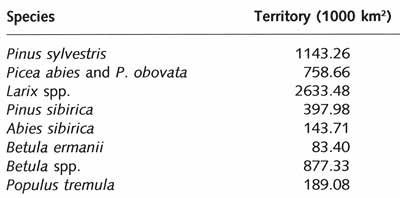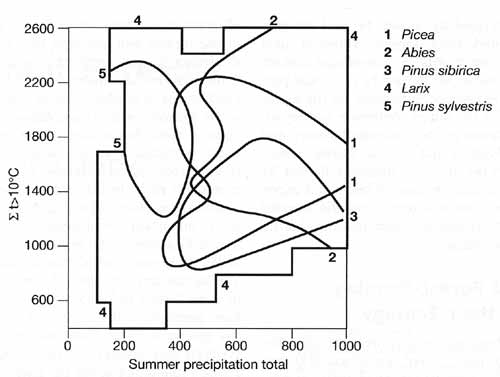Please put an active hyperlink to our site (www.rusnature.info) when you copy the materials from this page
Biomes and Regions of Northern Eurasia
Boreal Forests
<<< Introduction | Biomes & Regions Index | The Major Zones
and Sectors in the Taiga Biome >>>
The Principal Forest-forming Species and their Ecology
Although boreal forests occupy vast areas, the diversity of species is rather poor.
There are about 300 tree species in all but only about 30 occur widely (Isaev et al.,
1995). Forests composed of Larix sibirica, L. gmelinii (the previous name of this species
is L. dahurica) and a few other species in this genera are the most extensive and cover
about 263 million hectares east of the Yenisey. Being very undemanding to climate, Larix
forms the northern tree line across most of the area and extends southwards to the dry
steppes. It is Larix forests that develop in the coldest place in the Northern Hemisphere,
the Verkhoyansk region, and grow on the permafrost. Under favourable conditions, Larix
trees can live for over 300 years, reaching about 50 meters in height. However, the severe
climate of the northern taiga subzone and Eastern Siberia act adversely on Larix and it
rarely reaches a great size there. Other common forest-forming species are Picea spp.,
Pinus sibirica, Abies sibirica, and Pinus sylvestris (Table 9.1).

Table 9.1 Territories occupied by various tree species in the taiga zone
Picea is the second most widespread taiga tree species whose centre of origin is in
China. Two species prevail: Picea abies in the central and northern East European plain
and P. obovata in northern European Russia, Western and Central Siberia, and the mountains
of Southern Siberia. Further east in southern Sakha-Yakutia and the Pacific sector, Picea
ajanensis occurs. Although a humble species, Picea is more demanding of the quality of
soil than Larix, particularly of the upper horizons where its shallow root system
develops. Abies trees, which often exceed 60 m in height, seldom form monodominant
communities. Most widespread is Abies sibirica which is an important forest-forming
species in the more humid locations in the north-east of European Russia, in Western and
Central Siberia, and in the Far East. The largest territory, over 10 million ha, is
occupied by Abies forests in Western Siberia where they extend from north to south for
over 1700 km. There are a few species of Pinus. Pinus sibirica grows in the Urals, Western
and Central Siberia; Pinus koraiensis covers about 4 million ha in the Far East; dwarf
Siberian pine Pinus pumila is particularly common in the mountains of Eastern Siberia, the
Transbaikal region and in the northern Far East. However, the largest areas are occupied
by Pinus sylvestris which is not a typical taiga species but a tree that grows in various
environments from the Baltic coast to the Pacific, from poorly developed sandy and rocky
soils to the peat bogs with a standing water layer of 20-50 cm. Large areas within the
coniferous forests biome are occupied by small-leaved deciduous species Betula and Populus
tremula.
The taiga species have adopted to low temperatures, sharp seasonal contrasts in
temperature and humidity, a prolonged period of snow cover, and seasonal freezing of soil.
Among tree species, Picea and Larix (particularly Larix gmelinii) are best adapted to the
extremely low winter temperatures (Figure 9.1), while Larix gmelinii and Pinus pumila best
withstand aridity and sharp seasonal temperature contrasts.

Fig. 9.1 Climatic characteristics favouring the growth of various
forest-forming species. After Puzachenko and Skulkin (1981)
All conifers in the boreal forest biome are evergreen apart from Larix which sheds its
leaves annually. Because no time is required by the evergreen conifers to develop new
foliage, they use most of the growing season which is limited to about 30 days in the
northernmost regions and 120 days in the south (Walter, 1985). Conifers begin
photosynthesis at relatively low temperatures and have low light requirements although
growth can be limited if the trees are unable to take moisture from frozen ground.
Most of the coniferous forests are located within the permafrost zone. The distribution
of tree species depends on permafrost conditions and most importantly on the thickness of
the active layer (the layer of ground which is subject to annual thawing and freezing).
The areas with a thin active layer of 50-100 cm are populated by Picea and Larix which
have very shallow root systems confined to the upper 20 cm of soil. Other coniferous and
small-leaved deciduous species have deeper root systems and require habitats with a deeper
active layer.
In the coniferous forest zone, soils are relatively infertile. Nitrogen is recycled in
the ecosystem through the decomposition of litter at a slow rate because conifer litter
has high concentrations of wax, resin, and lignin, which restricts the activity of
microflora (Millar, 1974), and because low temperatures and permafrost slow down the
return of minerals (Cole and Rapp, 1981). Mosses, abundant in boreal forests, create
additional nutrient stress. First, mosses insulate the ground and decomposition is
therefore reduced because of low soil temperatures (Van Cleve et al., 1983); second, they
absorb moisture and nutrients and less minerals are delivered to the tree roots below
(Oechel and Van Cleve, 1986). In contrast to the cold tundra soils, the taiga soils are
dominated by microscopic fungi that play an important role in the decomposition of dead
phytomass. The acidity of a soil aids the destruction of its mineral components and the
washing of minerals into the lower horizons inaccessible for tree roots. Therefore,
infertility of soil is compensated for by the easier access to organic nutrients due to
the activity of microorganisms in the upper soil horizons where root system develops. As a
result, in the taiga high phytomass reserves with low ash content form (Bazilevich and
Tishkov, 1986). Parasites (mosquitoes, midges, horseflies, etc.), which are abundant in
taiga, also participate in the microelement cycle by transporting ash elements and
nitrogen from floodplains and water bodies to the watersheds occupied by coniferous
forests.
<<< Introduction | Biomes & Regions Index | The Major Zones
and Sectors in the Taiga Biome >>>
Contents of the Boreal Forests section:
Other sections of Biomes & Regions:
|
|